Pipefitter/Project Foreman Died When Struck by Ruptured Sewer Pipe/Mechanical Plug
Michigan Case Report: 07MI024
Summary
On March 30, 2007, a 53-year-old male pipefitter and project foreman for a mechanical contractor died when a storm sewer pipe and inflatable plug dislodged and struck him causing fatal injuries to his chest and abdomen. The three-person crew was in a county park’s lift station to replace two pumps. The water was pumped down and the decedent and Coworker #1 went down to the bottom of the manhole to install a mechanical plug into a 26-inch diameter storm sewer pipe that drained into the lift station. The plug was inflated and the water stopped flowing into the station. Coworker #2 was at the top of the 10- x 10-foot manhole monitoring the situation. The decedent and Coworker #1 installed a pump base anchor in the floor directly in front of the mechanical plug they had installed in the sewer line. No blocking or bracing was installed in front of the plug. While the decedent and Coworker #1 were drilling anchor holes in the floor, the wall, sewer pipe and plug exploded into the manhole, striking both employees (Figure 1). The decedent was knocked unconscious and Coworker #1 was thrown across the lift station. Coworkers #1 and #2 lifted the decedent to the 2nd level of the lift station and started CPR. When emergency response arrived, they extricated the decedent from the 2nd level and transported him to a local hospital where he later died.
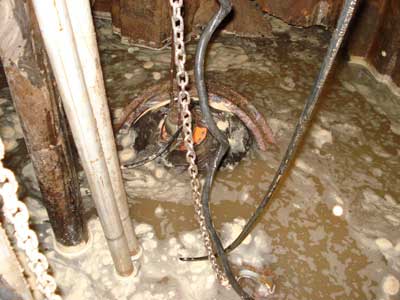
|
|
Figure 1. Pipe plug in broken sewer pipe at base of lift station
|
Recommendations:
- Employers should ensure that workers follow all pneumatic pipe plug manufacturer’s safety recommendations and other safety precautions relevant to the safe installation and use of pneumatic pipe plugs.
- Employers should develop written confined space programs that contain specific procedures for all tasks to be performed and ensure employees follow the procedures.
- Employers should institute a Health and Safety (H&S) committee as part of their health and safety program.
- Employers should provide workers with training in the recognition and avoidance of unsafe conditions and the required safe work practices that apply to their work environments.
Introduction
On March 30, 2007, a 53-year-old male pipefitter/project foreman for a mechanical contractor died when storm sewer pipe and inflatable pneumatic plug ruptured and struck him in his chest and abdomen. On the same day as the fatal incident, MIFACE investigators were informed by the Michigan Occupational Safety and Health Administration (MIOSHA) personnel, who had received a report on their 24-hour-a-day hotline that this work-related fatal injury had occurred. On July 10, 2007, MIFACE interviewed the company owner at the company headquarters and was given a tour of the facility. During the course of writing this report, the police report and pictures, fire response report, medical examiner report, and the MIOSHA file and citations were reviewed. The pictures used in Figures 1 and 3 are courtesy of the company owner. Figures 2, 4, 5, and 6 are courtesy of the MIOSHA file.
The employer, a mechanical installation contractor for commercial, industrial, and institutional facilities had been in business for over 25 years. The firm employed 85 individuals, 12 of whom had the same job title as the decedent, project foreman. The decedent had been employed with this firm for 20 years and worked full time. Employees worked 9 hours per day, starting work at 6:00 a.m. and concluding at 4:00 p.m.
The employer had a written health and safety program, but no specific procedures for the task being performed. The company did not have a Health and Safety Committee. The firm participated in the National Associated Builders and Contractors Inc. 2007 Safety Training and Evaluation Process (STEP) program and had been awarded a “Gold Level Achievement Award.” The company had a written progressive disciplinary procedure: 1st violation resulted in a verbal warning, the 2nd violation resulted in a written warning, and the 3rd violation resulted in possible termination.
The company’s safety director was a health and safety consultant employed by a consulting firm. The safety director had many responsibilities, including conducting regular safety inspections of shop and field operations, as well as holding safety meetings with all employees and conducting safety training of supervisory personnel. The safety director visited company job sites two times per month and provided the company owner a written report on noted violations. Crew foremen were responsible for safety at the job site (instruct crew in proper and safe operation of tools, equipment and procedures for every job) and to correct all noted violations at the time of the consultant’s site visit. The foreman was responsible for conducting adequate safety briefings and inspection of tools as well as equipment before any job was started. The crew foreman observed work in progress to ensure that safety precautions were taken at all times, and was required to take immediate steps to correct any unsafe procedure or hazardous condition. The employer, safety consultant, and crew foreman presented health and safety training and topics to company employees. Employees received health and safety training on an annual basis by the safety consultant. The crew foreman was responsible for presenting specific health and safety topics during monthly safety meetings and weekly toolbox talks, and for maintaining training documentation. Supervisors and foreman were responsible for determining if an employee needed retraining.
The company had a written confined space entry program. The decedent had been trained and authorized to use the confined space gas monitor in 1997. A confined space entry permit had been developed to monitor for oxygen, carbon monoxide, and LEL.
At the conclusion of their investigation, MIOSHA Construction Safety and Health Division issued the following Serious citations to the employer:
- SERIOUS: ACT 154 ACT OF 1974, 408.1011(a)
- An employer should furnish to each employee, employment and a place of employment which is free from recognized hazards that are causing, or are likely to cause, death or serious physical harm to the employee.
The employees engaged in mechanical activities failed to follow the manufacturer’s installation instruction of a Lansas® pneumatic pipe plug. The employees were exposed to serious injury/death when the sewer pipe and pneumatic pipe plug failed.
The employees failed to:- Read the manufacturer’s installation instructions.
- Perform head/test pressure calculations.
- Install the pipe plug in a clean dry pipe.
- Install shoring/bracing in front of the pipe plug to prevent dislodgement.
- Check the calibration of the air pressure gauge.
- The employees were working in the danger zone.
Method of abatement would be to follow Lansas® manufacturer’s instructions for pneumatic pipe plugs.
- SERIOUS: GENERAL RULES, PART 1, RULE 114(2)(g)
- An accident prevention program shall, as a minimum, provide for the following: Instruction to each employee who is required to enter a confined space regarding all of the following:
- The hazards involved.
- The necessary precautions to be taken.
- The use of required personal protective equipment.
- Emergency equipment.
- The procedures to be followed in an emergency occurs.
Employees engaged in mechanical activities failed to address hazards associated with confined spaces. The employees failed to recognize engulfment hazards, wear a safety harness with a lifeline attached, and have the proper emergency equipment available. The employees were exposed to injury and drowning hazards when the sewer pipe and plug failed.
- SERIOUS: TOOLS, PART 19, RULE 1931(1)(a)(b)
- An employer shall do all of the following: (a) Ensure that an employee has been trained in the use of tools before authorizing their use and (b) maintain, or require to be maintained, tools free of defects that could cause injury to an employee.
The employees engaged in mechanical work activities were not properly trained in the installation and use of a Lansas® inflatable pipe plug. The employees were exposed to serious injury/death when the sewer pipe and plug failed.
Investigation
The company for whom the decedent (Company A) worked had been contracted by a county parks department to replace two old and failing pumps and a ladder at a park lift station. Company B was subcontracted to install the ladder. The park’s storm water drains into the lift station and the lift station then lifts the water to a local river. The manhole had corrugated metal walls. The base of the lift station was 30 feet deep. There was a 2nd level, accessible by ladder approximately 15 feet down. The 2nd level had a 2-foot walk around. A ladder provided access to the base of the manhole where the work was to be performed.
On the day before the incident, Company A’s field superintendent conducted an informal inspection of the lift station and found nothing out of the ordinary. The superintendent did find that the sewer pipe, which was installed in the 1920s, was larger than expected.
Company A usually used Cherne® Best Ball 18″-1 ½” mechanical plugs, installing them per manufacturer’s instructions. Because Company A did not have the properly sized plug for the pipe, the field superintendent borrowed a Lansas® 24-48-inch pneumatic pipe plug from a local contractor. According to the MIOSHA file, no safety instructions were given to the Company A employee who picked up the Lansas® plug. The company from whom the plug was rented did not have records of gauge calibration. According to the MIOSHA file, if the gauges appeared to be faulty, they were discarded and replaced. The superintendent did not obtain any manufacturer’s installation instructions from the local contractor. The decedent and Coworker #1 transported this larger plug to the lift station.
The decedent and Coworker #1 arrived at the company shop location at 5:45 a.m. They loaded a truck with a generator, air compressor, air line, safety harnesses, hoist block (chain fall), test equipment for air monitoring, and other miscellaneous tools. They arrived at the worksite at approximately 7:30 a.m. The weather was sunny and chilly.
The decedent and Coworker #1 began to unload the truck. They set up a 2-inch sump pump. After evaluating the air in the confined space, the decedent descended into the manhole as Coworker #1 lowered the sump pump into manhole. The decedent placed it in the rear corner of work area. They turned on the pump and water began to discharge through a hose onto the above ground street.
The decedent left the work site and traveled to another nearby project to pick up rubber thigh-high boots. Coworker #1 began to set up the chain fall, hooked up the test plug and began to lower it into the manhole, and set up the air compressor, generator, and tools. He also opened up the electrical cabinet.
At approximately 8:00 a.m., Coworker #2 arrived at the jobsite (Figure 2). Coworker #1 and Coworker #2 began to discuss the work plan. A representative from the county’s park department arrived and asked “What are you doing today?” and “What is the game plan?” Coworkers #1 and #2 responded and then prepared for the confined space documentation and equipment. They went through the checklist, turned on the atmospheric testing equipment (sniffer) and lowered it down into the manhole. Coworker #2 checked the readings from the sniffer and verbalized the readings.
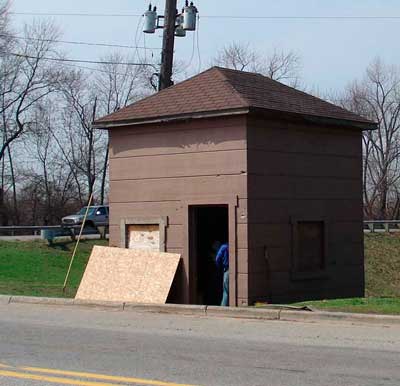 |
|
Figure 2. Lift station building
|
The decedent arrived with the boots as Coworkers #1 and #2 were finishing the confined space readings. The decedent and Coworker #2 put on the rubber boots. At approximately 9:00 a.m., the decedent and Coworker #2 entered the manhole while Coworker #1 stayed above ground at the open manhole to observe and listen. Coworker #1 released the hoist while lowering the plug.
With constant verbalization and teamwork between the three men, it took approximately 15 to 17 minutes to lower the test plug into the manhole and to place it into the sewer pipe. Coworker #2 used the shovel to clean the 26-inch cast iron sewer pipe. The decedent guided the plug into the sewer pipe while Coworker #2 used the wooden handle of the shovel to help insert the plug. After the pipe plug was positioned, they told Coworker #1 to turn on the air compressor to inflate the plug. Coworker #1 did so and monitored the air gauge. Employee statements provided to the MIFACE researcher stated that the plug was pumped per manufacturer’s recommendations to eight pounds. Statements made to the MIOSHA compliance officer differed from the employee statements given to the MIFACE researcher. The employee statements given to the MIOSHA compliance officer at the time of the investigation indicated that the employees did not know the required plug inflation pressure or the plug’s inflation pressure at the time of the incident. The decedent and Coworker #2 stayed in the bottom of the lift station and yelled up to Coworker #1 when the water stopped flowing from the sewer pipe. Coworker #1 communicated to the decedent and Coworker #2 that all systems were good. Coworker #1 then collected the necessary tools in a bucket, and while watching the air gauge, he lowered the bucket to the crew below.
Coworker #1 was at the top of the manhole monitoring the situation and the pump. The decedent and Coworker #2 then proceeded to install a pump base anchor in the floor directly in front of the mechanical plug they installed in the sewer line. No blocking or bracing was installed in front of the plug as required by the manufacturer to protect the workers in case of a plug failure
Coworker #2 used the shovel to clear six to eight inches of sand away from the working area to determine what kind of anchors were required. The 2-inch sump pump continued to keep the water level under control. They decided what anchors were needed and then headed back up out of the manhole.
Employees from Company B arrived at the pump house. Company B’s employees entered the well house and descended to the second level to discuss the installation procedure for the new ladder. A Company B employee reviewed the ladder installation procedure with the decedent and then left the jobsite. The decedent left the jobsite to obtain materials needed for the anchor and ladder installation. Coworker #2 went back down into the manhole after discussing the game plan with the Company B. Coworker #2 chopped out the old ladder and it was pulled out and then the new one was dropped into the manhole. Coworker #2 exited the manhole and Company B employees entered and after determining that the ladder was properly set, left the manhole.
When the decedent arrived back at the jobsite, the decedent and Coworker #2 descended to the lower level of the manhole to install the anchors. They took a small drill with them. They discovered the drill had the wrong size bit. After discussing various options, the decedent and Coworker #2 still could not drill with the small drill. They yelled up to Coworker #1 to get the big drill, which was already loaded and ready to go. Coworker #1 lowered the drill down while continuing to monitor the air.
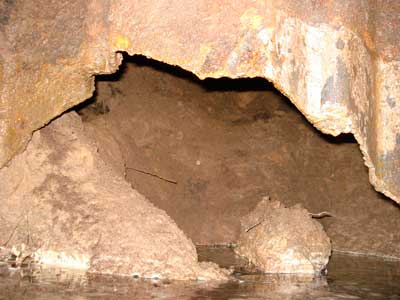 |
|
Figure 3. Manhole wall at location of pipe explosion
|
Within the next 60 seconds, they noticed the sump pump was not keeping up and water was coming in and had risen to their ankles. Water was leaking from the wall, not out of the pipe. The decedent knelt down to drill the second hole with the drill. Coworker #2 saw brownish water in the bottom corner near the plug. Coworker #2 told the decedent to move out of the way, he would take care of the anchor. He was on his knees 15 inches away from the decedent.
When Coworker #2 knelt down, he felt air by his face as the force of the explosion picked him up and blew him to the other side of the manhole (Figure 3). Coworker #2 was uncertain if he was knocked unconscious or if so, the length of time he was unconscious. He got up from a fetal position and water in the manhole was chest high. As he came to, he went to the decedent who was visibly injured. Coworker #2 looked up toward the top of the manhole, but it was “raining” air – the air was filled with white powder and dust particles. Coworker #1 could not see the two individuals in the manhole. Coworker #2 yelled to Coworker #1,”we’re in trouble.” He instructed Coworker #1 to call 911, and then to call the company office.
Coworker #2 had difficulty in pulling the decendent above the water because of the height of the water/mud/sand. Coworker #2 told Coworker #1 to turn the big pumps on; Coworker #1 complied. Coworker #2 asked Coworker #1 for a pipe strap so he could hoist the decedent. He lassoed the decedent under the arms to pull him up. Coworker #1 began hoisting the decedent out of the water while Coworker #2 yelled instructions from below. Coworker #2 ascended to the 2nd level and laid the decedent on two 2×10 boards. He asked Coworker #1 to come down to the 2nd level because he realized the decedent was not breathing. Coworker #2 held the decedent against his leg as Coworker #1 administered CPR. The decedent began to breathe.
The police arrived first. Then an EMT arrived and inquired if it was sewage in the hole. Coworker #2 responded that it was groundwater. When individuals from a local fire department technical rescue team arrived, they assumed command. After assessing the situation, they entered the manhole, assisted the EMT and asked Coworkers #1 and #2 to leave. The rescue workers moved the decedent from the boards to a stokes basket and the decedent was lifted from the manhole. EMT personnel transported the decedent by ambulance to a local hospital where he died several hours later.
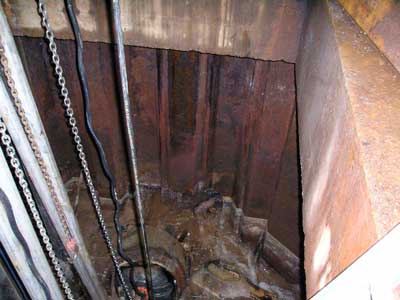 |
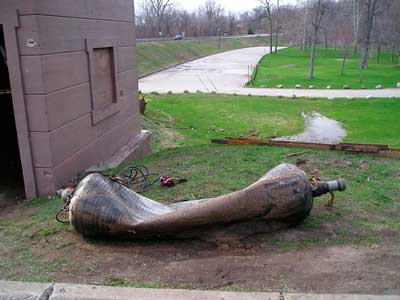 |
|
Figure 5. Picture of pipe plug after it was removed from the manhole
|
The pipe plug was found laying on the floor of the manhole and recovered. When the water was pumped out, the plug in the pipe could be seen (Figure 4). Part of the concrete pipe was still attached to the plug. The plug was over eight feet long and had metal plugs on both ends (Figure 5). Pictures indicate that the concrete gave way causing the plug to shoot out due to water pressure (Figure 3). The plug had an approximately 16-inch cut that appeared to happen when the pipe broke. The cut looked as though it was done by a sharp object and not from blowing under pressure (Figure 6). The entire plug would have been inside of this pipe prior to it blowing out.
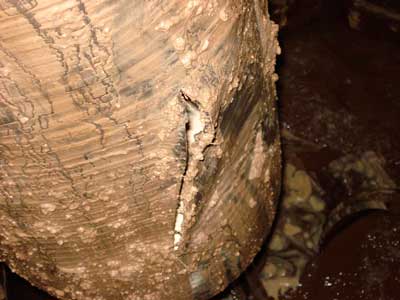 |
|
Figure 6. 16-inch cut on pipe plug
|
The MIOSHA file documentation indicated that both surviving Company A employees had never used or installed this type of large inflatable plug before, had not read the manufacturer’s instructions (including installation instructions), and had not received any formal training about this plug from their employer. They stated they had used the smaller pipe plugs that their company owned many times before and that they did not install this pipe plug any differently from their work practice in the past. Company A had the manufacturer’s installation instruction for the pipe plugs usually used at the company’s office.
The employees also indicated that they did not know if the pressure gauge on the rented pipe plug had been calibrated. The work crew had not made any back test pressure calculations or head pressure/back pressure calculations.
Back to Top
Cause of Death
The cause of death as stated on the death certificate was multiple blunt injuries of chest and abdomen. Toxicology was negative for alcohol and illicit drugs.
Back to Top
Recommendations/Discussion
Employers should ensure that workers follow all pneumatic pipe plug manufacturer’s safety recommendations and other safety precautions relevant to the safe installation and use of pneumatic pipe plugs.
The employer usually used Cherne® pipe plugs, but for this worksite, they used a Lansas® pipe plug. The employer had the Cherne® safety literature at the company headquarters, but had not obtained any Lansas® pipe plug literature.
MIFACE conducted an Internet search and found safety information for both the Lansas® and Cherne® pipe plugs. The Lansas® Products websiteexternal icon (http://www.lansas.com/index.htm) had both written safety instructions and viewable safety videos (in both English and Spanish). The Cherne® Safety Manualexternal icon may be found at: http://www.cherneind.com/data/. (Link updated 3/26/2009) Click on Literature, and scroll down to Safety Information.
The company and the safety director should obtain and review the safety literature for any pipe plugs they use and ensure that the safety protocols are understood and followed. Safety precautions identified in the installation instructions for the Cherne® plugs and the Lansas® pipe plug used in the incident were strikingly similar. Table I highlights some of these precautions.
|
Table I
|
|
| Cherne Pipe Plugs |
Lansas Pipe Plug |
| Death/bodily injury may result if plug fails | Same |
| Read and understand installation instructions prior to use | Same |
| Determine back-test pressures | Same |
| Always use calibrated gauges | Required use of calibrated gauges |
| Insert plugs in clean dry pipes | Same |
| Unclean pipes may affect holding capabilities of pipe plugs | Same |
| Stay out of Danger Zone | Same |
| Never rely on pipe plugs as the only means to prevent injury. Bracing is required. | Always block/brace to prevent movement of pipe plugs. |
The crew stated to the MIOSHA compliance officer that they installed the Lansas® plug in the same manner as they would have installed the Cherne® plug (the plug they usually used). The “normal” manner was in violation of the Cherne® Safety Instruction manual. For example:
- The decedent and his coworker were in the danger zone during plug installation. The danger zone is the area that exists in front of the plugged pipe opening in an area, which expands outwardly in a cone shape).
- The employer did not consult a registered professional engineer for the design, construction, and maintenance of an operational backup system to safely stop a dislodged plug, and the pipeline media that will discharge upon plug failure, to protect employees while performing the pump/ladder replacement working in the danger zone. Blocking/bracing must be used to prevent the movement or complete dislodging of pipe plugs. Employers should consult the engineer on a case-by-case basis.
The employees indicated that no water was flowing from the pipe after the plug was inflated. This may have placed undue pressure on the pipe, potentially contributing to its failure. Although it is unknown if the plug was over inflated, over inflation will not provide a better seal and the plug may rupture catastrophically and dislodge at high velocity.
Employers should develop written confined space programs that contain specific procedures for all tasks to be performed and ensure employees follow the procedures.
A confined space means any space having a limited means of egress that is subject to the accumulation of toxic or flammable contaminants or has an oxygen deficient atmosphere. Confined or enclosed spaces include, but are not limited to, storage tanks, process vessels, bins, boilers, ventilation or exhaust ducts, sewers, underground utility vaults, tunnels, pipelines, and open top spaces more than four feet in depth such as pits, tubs, vaults, and vessels.
Some of the company’s confined space protocols were followed, for example, evaluating the air prior to entry and having an employee available in the immediate vicinity to assist in rendering assistance. A hazard assessment of a job that requires working in a lift station manhole should identify possible engulfment if the plug or wall should fail. With this hazard identification, the confined space procedure should identify that safety harnesses be worn by each of the employees in the manhole. Although the wearing of the safety harnesses would not have prevented the fatality, the rescue of the injured worker would have proceeded more quickly and at less risk to the injured.
Employers should institute a Health and Safety (H&S) committee as part of their health and safety program.
An H&S Committee, comprised of both management and hourly employees provides a forum for management and employees to regularly discuss health and safety issues in the workplace. An H&S Committee is an important way for employees to help manage their own health and safety and assist the employer in providing a safer, healthier workplace. The formation of the Committee provides a process for open communication on health and safety issues and enhances the ability of employees and management to resolve safety and health concerns reasonably and cooperatively.
Much of the potential value of an H&S Committee can be lost without careful development of the purpose, functions and activities of the Committee. The Committee will function effectively only after the need for the committee is recognized and employees, supervisors and managers welcome its services. At their worst, Health and Safety Committees can be a “negative-minded” group confining their approach primarily to (after-the-fact) placing of blame. However, at their best, they can become an effective tool to help prevent unsafe practices and conditions, reduce the risk of injury and illnesses and to help motivate employees and supervisors to become actively involved.
MIOSHA has several resources that can be accessed for development of an effective Health and Safety Committee. The Good Safety and Health Programs are Built with Good Safety Committees brochure details the advantages of having an effective Health and Safety Committee (www.michigan.gov/documents/cis_wsh_cet0140_103132_7.pdf). (Link no longer available 4/21/2009) The MIOSHA Safety and Health Toolbox contains materials that focus on the major components of a health and safety system. Module 2 of the Toolboxexternal icon focuses on employee involvement and contains several resources for Health and Safety Committee development (http://www.michigan.gov/lara/0,4601,7-154-61256_11407_15317-124535–,00.html) (Link updated 4/1/2013).
The State of Wisconsin “Guidelines for Developing an Effective Health and Safety Committeeexternal icon” (www.doa.state.wi.us/docs_view2.asp?docid=665) and the Canadian Centre for Occupational Health and Safety, Occupational Safety and Health Answersexternal icon: Health and Safety Committees (www.ccohs.ca/oshanswers/hsprograms/hscommittees/) both provide valuable resources and a framework for selection of H&S Committee membership, purpose, function and activities.
Employers should provide workers with training in the recognition and avoidance of unsafe conditions and the required safe work practices that apply to their work environments.
Employers should ensure that all employees are trained to recognize and avoid hazardous work conditions. Employers should also ensure that the training in recognizing and avoiding hazards is coupled with employer assessment that workers are competent in the recognition of hazards and safe work practices.
Because jobsite conditions change on a daily basis, MIFACE recommends that employers discuss the day’s work with the employees prior to the start of the work to discuss the day’s work. This could be accomplished in daily and weekly “tailgate” talks, covering applicable health and safety issues, weather issues, equipment issues, etc.
References
MIOSHA standardsexternal icon cited in this report may be found at and downloaded from the MIOSHA, Michigan Department of Labor and Economic Growth (DLEG) web site at: http://www.michigan.gov/mioshastandards. MIOSHA standards are available for a fee by writing to: Michigan Department of Labor and Economic Growth, MIOSHA Standards Section, P.O. Box 30643, Lansing, Michigan 48909-8143 or calling (517) 322-1845.
- MIOSHA Construction Safety and Health Standard, Part 1, General Rules.
- MIOSHA Construction Safety and Health Standard, Part 622. Control Measures For Hazardous Atmospheres In Confined Spaces For Construction.
- NIOSH FACE REPORT #9017. Sewer Worker Dies When Inflatable Sewer Plug Bursts in Washington, D.C. Internet Address: https://www.cdc.gov/niosh/face/In-house/full9017.html
- Cherne Industriesexternal icon. Internet Address: http://www.cherneind.com/ (Link updated 3/26/2009)
- Lansas Productsexternal icon. Internet Address: http://www.lansas.com/
Michigan FACE Program
MIFACE (Michigan Fatality Assessment and Control Evaluation), Michigan State University (MSU) Occupational & Environmental Medicineexternal icon, 117 West Fee Hall, East Lansing, Michigan 48824-1315. Internet Address: http://www.oem.msu.edu/MiFACE_Program.aspx. This information is for educational purposes only. This MIFACE report becomes public property upon publication and may be printed verbatim with credit to MSU. Reprinting cannot be used to endorse or advertise a commercial product or company. All rights reserved. MSU is an affirmative-action, equal opportunity employer. 4/23/08 (Link updated 8/5/2009)
MIFACE Investigation Report # 07MI024 Evaluationpdf iconexternal icon (see page 13 of report)
To contact Michigan State FACE program personnel regarding State-based FACE reports, please use information listed on the Contact Sheet on the NIOSH FACE web site Please contact In-house FACE program personnel regarding In-house FACE reports and to gain assistance when State-FACE program personnel cannot be reached.
